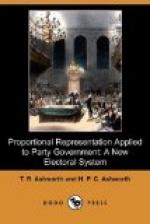The truth is that the present system has survived the passage from the first stage of representation into the second, not because it does justice to both parties, but because it has operated largely to prevent the formation of more than two parties. It has, therefore, been a means of giving effect to the central feature of representation, viz.: the organization of public opinion into two definite lines of policy. But it is a comparatively ineffective means, and it no longer suffices to prevent sectional delegation in any of the democracies we have examined. Besides, it is accompanied by a series of other evils, which in so far as they lead to the suppression of responsible leadership, tend to the degradation of public life. We propose now to consider the effect of the reform in remedying these defects of the present system.
+Parties Not Represented in the Legislature in the Same Proportion as in the Country.+—Representation under the present system is purely arbitrary; the amount which each party secures is a matter of chance. If a party with a majority in the whole country has a majority in each of the electorates it will secure all the representation. On the other hand, if it splits up its votes in each electorate, or even only in those electorates where it has a majority, it may secure none at all. Theoretically, then, any result is possible. The argument would lose its force, however, if in practice the result usually came out about right. But this seldom happens, and, speaking generally, two cases may be distinguished: first, when parties are nearly equal, the minority is almost as likely as the majority to return a majority of the representatives, thus defeating the principle of majority rule; and, second, when one party has a substantial majority, it generally sweeps the board and annihilates the minority. A few examples will illustrate these facts.
The 1895 election for the Imperial Parliament is analyzed by Sir John Lubbock in the Proportional Representation Review. He shows that out of 481 contested seats, the Liberals, with 1,800,000 votes were entitled to 242, and the Conservatives and Liberal Unionists, with 1,775,000 to 239, a majority of three seats for the Liberals. But the Conservatives and Unionists actually returned 279, and the Liberals only 202, a majority of 77 seats. The Conservatives and Unionists obtained also a majority of 75 of the uncontested seats, giving them a total majority of 152, instead of the 72 to which they were entitled.




